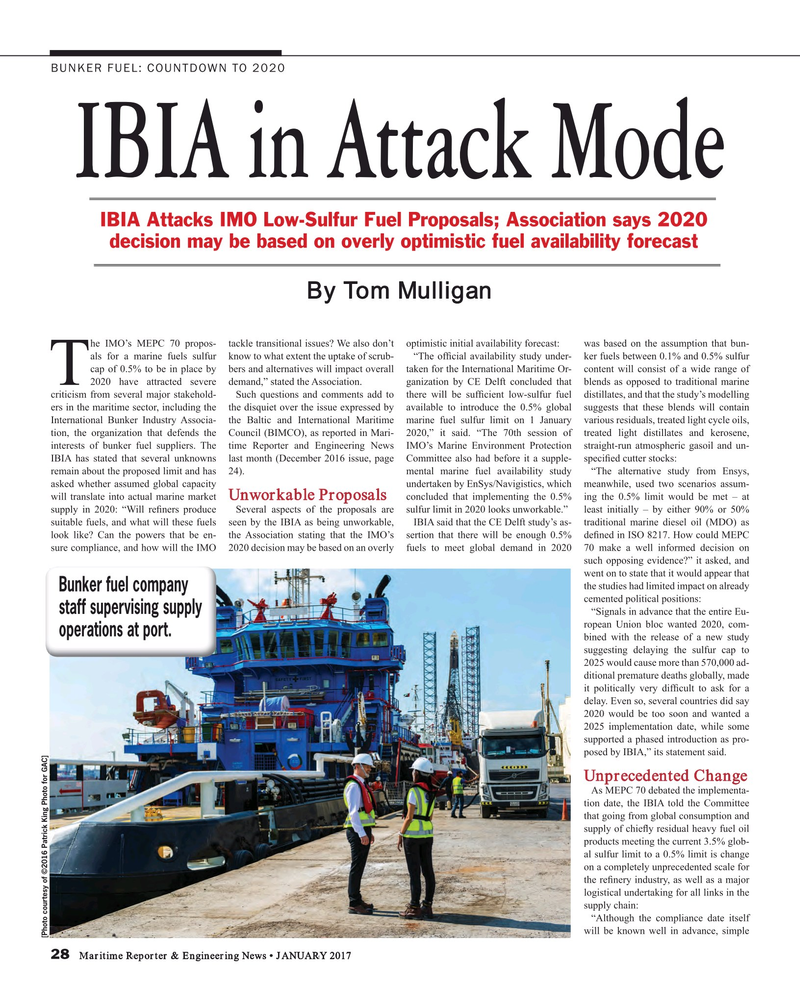
Page 28: of Maritime Reporter Magazine (January 2017)
The Ship Repair & Conversion Edition
Read this page in Pdf, Flash or Html5 edition of January 2017 Maritime Reporter Magazine
BUNKER FUEL: COUNTDOWN TO 2020
IBIA in Attack Mode
IBIA Attacks IMO Low-Sulfur Fuel Proposals; Association says 2020 decision may be based on overly optimistic fuel availability forecast
By Tom Mulligan he IMO’s MEPC 70 propos- tackle transitional issues? We also don’t optimistic initial availability forecast: was based on the assumption that bun- als for a marine fuels sulfur know to what extent the uptake of scrub- “The of? cial availability study under- ker fuels between 0.1% and 0.5% sulfur cap of 0.5% to be in place by bers and alternatives will impact overall taken for the International Maritime Or- content will consist of a wide range of
T2020 have attracted severe demand,” stated the Association. ganization by CE Delft concluded that blends as opposed to traditional marine criticism from several major stakehold- Such questions and comments add to there will be suf? cient low-sulfur fuel distillates, and that the study’s modelling ers in the maritime sector, including the the disquiet over the issue expressed by available to introduce the 0.5% global suggests that these blends will contain
International Bunker Industry Associa- the Baltic and International Maritime marine fuel sulfur limit on 1 January various residuals, treated light cycle oils, tion, the organization that defends the Council (BIMCO), as reported in Mari- 2020,” it said. “The 70th session of treated light distillates and kerosene, interests of bunker fuel suppliers. The time Reporter and Engineering News IMO’s Marine Environment Protection straight-run atmospheric gasoil and un-
IBIA has stated that several unknowns last month (December 2016 issue, page Committee also had before it a supple- speci? ed cutter stocks: remain about the proposed limit and has 24). mental marine fuel availability study “The alternative study from Ensys, asked whether assumed global capacity undertaken by EnSys/Navigistics, which meanwhile, used two scenarios assum- will translate into actual marine market concluded that implementing the 0.5% ing the 0.5% limit would be met – at
Unworkable Proposals supply in 2020: “Will re? ners produce Several aspects of the proposals are sulfur limit in 2020 looks unworkable.” least initially – by either 90% or 50% suitable fuels, and what will these fuels seen by the IBIA as being unworkable, IBIA said that the CE Delft study’s as- traditional marine diesel oil (MDO) as look like? Can the powers that be en- the Association stating that the IMO’s sertion that there will be enough 0.5% de? ned in ISO 8217. How could MEPC sure compliance, and how will the IMO 2020 decision may be based on an overly fuels to meet global demand in 2020 70 make a well informed decision on such opposing evidence?” it asked, and went on to state that it would appear that the studies had limited impact on already
Bunker fuel company cemented political positions: staff supervising supply “Signals in advance that the entire Eu- ropean Union bloc wanted 2020, com- operations at port.
bined with the release of a new study suggesting delaying the sulfur cap to 2025 would cause more than 570,000 ad- ditional premature deaths globally, made it politically very dif? cult to ask for a delay. Even so, several countries did say 2020 would be too soon and wanted a 2025 implementation date, while some supported a phased introduction as pro- posed by IBIA,” its statement said.
Unprecedented Change
As MEPC 70 debated the implementa- tion date, the IBIA told the Committee that going from global consumption and supply of chie? y residual heavy fuel oil products meeting the current 3.5% glob- al sulfur limit to a 0.5% limit is change on a completely unprecedented scale for the re? nery industry, as well as a major logistical undertaking for all links in the supply chain: “Although the compliance date itself will be known well in advance, simple [Photo courtesy of ©2016 Patrick King Photo for GAC] 28 Maritime Reporter & Engineering News • JANUARY 2017
MR #1 (26-33).indd 28 MR #1 (26-33).indd 28 1/9/2017 11:46:23 AM1/9/2017 11:46:23 AM

 27
27

 29
29
